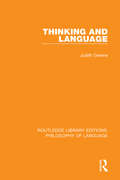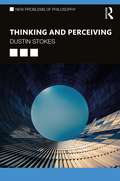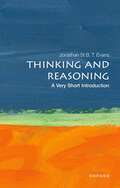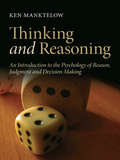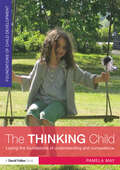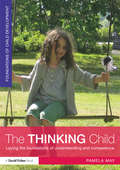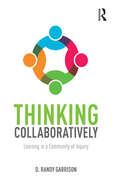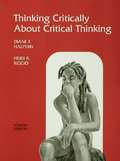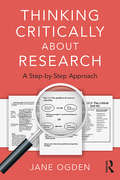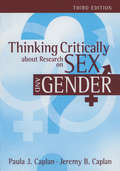- Table View
- List View
Thinking And Deciding
by Jonathan BaronBeginning with its first edition and through subsequent editions, Thinking and Deciding has established itself as the required text and important reference work for students and scholars of human cognition and rationality. In this fourth edition, first published in 2007, Jonathan Baron retains the comprehensive attention to the key questions addressed in the previous editions - how should we think? What, if anything, keeps us from thinking that way? How can we improve our thinking and decision making? - and his expanded treatment of topics such as risk, utilitarianism, Baye's theorem, and moral thinking. With the student in mind, the fourth edition emphasises the development of an understanding of the fundamental concepts in judgement and decision making. This book is essential reading for students and scholars in judgement and decision making and related fields, including psychology, economics, law, medicine, and business.
Thinking and Language
by Judith GreeneOriginally published in 1875, this book discusses thinking and language and traces the development of different pscyological approaches, assessing their theoretical significance and the experimental evidence behind them. It ends by drawing together the various lines of argument to arrive at some general conclusions about language and thought, since it clearly emerges that the two are inextricably linked.
Thinking and Language: Topics In Cognitive Psychology (Psychology Library Editions: Memory Ser.)
by Judith GreeneOriginally published in 1875, this book discusses thinking and language and traces the development of different pscyological approaches, assessing their theoretical significance and the experimental evidence behind them. It ends by drawing together the various lines of argument to arrive at some general conclusions about language and thought, since it clearly emerges that the two are inextricably linked.
Thinking and Learning Skills: Volume 2: Research and Open Questions (Psychology of Education and Instruction Series)
by S. F. Chipman J. W. Segal R. Glaser"First Published in 1985, Routledge is an imprint of Taylor & Francis, an informa company."
Thinking and Learning Skills: Volume 1: Relating Instruction To Research (Psychology of Education and Instruction Series)
by Judith W. Segal, Susan F. Chipman and Robert GlaserFirst Published in 1985. Routledge is an imprint of Taylor & Francis, an informa company.
Thinking and Learning Skills: Volume 1: Relating Instruction To Research (Psychology of Education and Instruction Series)
by J. W. Segal S. F. Chipman R. GlaserFirst Published in 1985. Routledge is an imprint of Taylor & Francis, an informa company.
Thinking and Learning Skills: Volume 2: Research and Open Questions (Psychology of Education and Instruction Series)
by Susan F. Chipman and Judith W. Segal and Robert Glaser"First Published in 1985, Routledge is an imprint of Taylor & Francis, an informa company."
Thinking And Learning With Ict: Raising Achievement In Primary Classrooms (PDF)
by Rupert Wegerif Lyn DawesPrimary teachers need to incorporate the use of computers in their daily lesson plans, but how can this be done most effectively to promote learning skills in the classroom? In this fascinating book, Lyn Dawes and Rupert Wegerif outline a strategy for enhancing the effectiveness of computers for teaching and learning with an emphasis on: * raising pupil achievement in the core subject areas * developing collaborative learning in small groups * using group discussions as a way of improving general communication, as well as thinking and reasoning skills. The approach is to use computers as a support for collaborative learning in small groups and this book presents ways to prepare pupils for talking, learning and thinking together around computers. Excerpts from pupils' discussions illustrate the main issues and guidance on lesson planning and developing and choosing appropriate software is also provided. Thinking and Learning with ICT will be a valuable resource for primary teachers and student teachers.
Thinking And Learning With ICT: Raising Achievement In Primary Classrooms
by Rupert Wegerif Lyn DawesPrimary teachers need to incorporate the use of computers in their daily lesson plans, but how can this be done most effectively to promote learning skills in the classroom? In this fascinating book, Lyn Dawes and Rupert Wegerif outline a strategy for enhancing the effectiveness of computers for teaching and learning with an emphasis on: * raising pupil achievement in the core subject areas * developing collaborative learning in small groups * using group discussions as a way of improving general communication, as well as thinking and reasoning skills. The approach is to use computers as a support for collaborative learning in small groups and this book presents ways to prepare pupils for talking, learning and thinking together around computers. Excerpts from pupils' discussions illustrate the main issues and guidance on lesson planning and developing and choosing appropriate software is also provided. Thinking and Learning with ICT will be a valuable resource for primary teachers and student teachers.
Thinking and Perceiving (New Problems of Philosophy)
by Dustin StokesHuman beings are in contact with the world through their minds. One can make sensory perceptual contact with the world: One sees the tree and hears its leaves flutter. And one makes cognitive contact with the world: One forms beliefs about the tree, memories of how it was in the past, and expectations of how it will be in the future. Can the first, perception, be influenced in important ways by the second, cognition? Do cognitive states such as memories, beliefs, and expectations affect what one perceives through the senses? And what is the importance of these possible relations to how we theorize and understand the human mind? Possible cognitive influence on perception (sometimes called "cognitive penetration of perception") has been long debated in philosophy of mind and cognitive science: Some argue that such influence occurs, while others argue that it does not or cannot. In this excellent introduction and overview of the problem, Dustin Stokes examines the following: The philosophical and scientific background to cognition and perception Contemporary ways of distinguishing cognition and perception Questions about the representational content of perception versus cognition Distinct theories of mental architecture: modularity versus malleability Consequences for epistemology, philosophy of science, and aesthetics Philosophical and scientific research on perceptual attention Perceptual skill, learning, and expertise Perceptual content, objectivity, and cultural bias. Additional features, such as chapter summaries, suggestions for further reading, and a glossary, make Thinking and Perceiving an ideal resource for students of philosophy of mind and psychology, cognitive psychology, and cognitive science.
Thinking and Perceiving (New Problems of Philosophy)
by Dustin StokesHuman beings are in contact with the world through their minds. One can make sensory perceptual contact with the world: One sees the tree and hears its leaves flutter. And one makes cognitive contact with the world: One forms beliefs about the tree, memories of how it was in the past, and expectations of how it will be in the future. Can the first, perception, be influenced in important ways by the second, cognition? Do cognitive states such as memories, beliefs, and expectations affect what one perceives through the senses? And what is the importance of these possible relations to how we theorize and understand the human mind? Possible cognitive influence on perception (sometimes called "cognitive penetration of perception") has been long debated in philosophy of mind and cognitive science: Some argue that such influence occurs, while others argue that it does not or cannot. In this excellent introduction and overview of the problem, Dustin Stokes examines the following: The philosophical and scientific background to cognition and perception Contemporary ways of distinguishing cognition and perception Questions about the representational content of perception versus cognition Distinct theories of mental architecture: modularity versus malleability Consequences for epistemology, philosophy of science, and aesthetics Philosophical and scientific research on perceptual attention Perceptual skill, learning, and expertise Perceptual content, objectivity, and cultural bias. Additional features, such as chapter summaries, suggestions for further reading, and a glossary, make Thinking and Perceiving an ideal resource for students of philosophy of mind and psychology, cognitive psychology, and cognitive science.
Thinking and Problem Solving (Handbook Of Perception And Cognition #Volume 2)
by Robert J. SternbergThinking and Problem-Solving presents a comprehensive and up-to-date review of literature on cognition, reasoning, intelligence, and other formative areas specific to this field. Written for advanced undergraduates, researchers, and academics, this volume is a necessary reference for beginning and established investigators in cognitive and educational psychology. Thinking and Problem-Solving provides insight into questions such as: how do people solve complex problems in mathematics and everyday life? How do we generate new ideas? How do we piece together clues to solve a mystery, categorize novel events, and teach others to do the same? Provides a comprehensive literature review Covers both historical and contemporary approaches Organized for ease of use and reference Chapters authored by leading scholars
Thinking and Reasoning: Dual Processes In Reasoning And Judgement (Very Short Introductions)
by Jonathan St EvansOur extraordinary capacity to reason and solve problems sets us aside from other animals, but our evolved thinking processes also leave us susceptibile to bias and error. The study of thinking and reasoning goes back to Aristotle, and was one of the first topics to be studied when psychology separated from philosophy. In this Very Short Introduction Jonathan Evans explores cognitive psychological approaches to understanding the nature of thinking and reasoning, problem solving, and decision making. He shows how our problem solving capabilities are hugely dependent on also having the imagination to ask the right questions, and the ability to see things from a completely new perspective. Beginning by considering the approaches of the behaviourists and the Gestalt psychologists, he moves on to modern explorations of thinking, including hypothetical thinking, conditionals, deduction, rationality, and intuition. Covering the role of past learning, IQ, and cognitive biases, Evans also discusses the idea that there may be two different ways of thinking, arising from our evolutionary history. ABOUT THE SERIES: The Very Short Introductions series from Oxford University Press contains hundreds of titles in almost every subject area. These pocket-sized books are the perfect way to get ahead in a new subject quickly. Our expert authors combine facts, analysis, perspective, new ideas, and enthusiasm to make interesting and challenging topics highly readable.
Thinking and Reasoning: An Introduction to the Psychology of Reason, Judgment and Decision Making
by Ken Manktelow Niall GalbraithThe area of psychological research reviewed in this book is one that is not only increasing in popularity in college curricula, but is also making an ever larger impact on the world outside the classroom. Drawing upon research originally cited in Ken Manktelow’s highly successful publication Reasoning and Thinking, this completely rewritten textbook reflects on the revolutionary changes that have occurred in the field in recent years, stemming from the huge expansion in research output, as well as new methods and explanations, and the appearance of numerous books on the subject aimed at the popular market. The main areas covered are probability judgment, deductive and inductive reasoning, decision making, hypothetical thinking and rationality. In each case, the material is almost entirely new, with topics such as the new paradigm in reasoning research, causal reasoning and counterfactual thinking appearing for the first time. The book also presents an extended treatment of decision making research, and contains a chapter on individual and cultural influences on thinking. Thinking and Reasoning provides a detailed, integrated and approachable treatment of this area of cognitive psychology, and is ideal reading for intermediate and advanced undergraduate students; indeed, for anyone interested in how we draw conclusions and make choices.
Thinking and Reasoning: An Introduction to the Psychology of Reason, Judgment and Decision Making
by Ken Manktelow Niall GalbraithThe area of psychological research reviewed in this book is one that is not only increasing in popularity in college curricula, but is also making an ever larger impact on the world outside the classroom. Drawing upon research originally cited in Ken Manktelow’s highly successful publication Reasoning and Thinking, this completely rewritten textbook reflects on the revolutionary changes that have occurred in the field in recent years, stemming from the huge expansion in research output, as well as new methods and explanations, and the appearance of numerous books on the subject aimed at the popular market. The main areas covered are probability judgment, deductive and inductive reasoning, decision making, hypothetical thinking and rationality. In each case, the material is almost entirely new, with topics such as the new paradigm in reasoning research, causal reasoning and counterfactual thinking appearing for the first time. The book also presents an extended treatment of decision making research, and contains a chapter on individual and cultural influences on thinking. Thinking and Reasoning provides a detailed, integrated and approachable treatment of this area of cognitive psychology, and is ideal reading for intermediate and advanced undergraduate students; indeed, for anyone interested in how we draw conclusions and make choices.
Thinking and Reasoning: A Very Short Introduction (Very Short Introductions)
by Jonathan St EvansOur extraordinary capacity to reason and solve problems sets us aside from other animals, but our evolved thinking processes also leave us susceptibile to bias and error. The study of thinking and reasoning goes back to Aristotle, and was one of the first topics to be studied when psychology separated from philosophy. In this Very Short Introduction Jonathan Evans explores cognitive psychological approaches to understanding the nature of thinking and reasoning, problem solving, and decision making. He shows how our problem solving capabilities are hugely dependent on also having the imagination to ask the right questions, and the ability to see things from a completely new perspective. Beginning by considering the approaches of the behaviourists and the Gestalt psychologists, he moves on to modern explorations of thinking, including hypothetical thinking, conditionals, deduction, rationality, and intuition. Covering the role of past learning, IQ, and cognitive biases, Evans also discusses the idea that there may be two different ways of thinking, arising from our evolutionary history. ABOUT THE SERIES: The Very Short Introductions series from Oxford University Press contains hundreds of titles in almost every subject area. These pocket-sized books are the perfect way to get ahead in a new subject quickly. Our expert authors combine facts, analysis, perspective, new ideas, and enthusiasm to make interesting and challenging topics highly readable.
The Thinking Child: Laying the foundations of understanding and competence
by Pamela MayWhat characteristics do children need to become motivated to learn? How do children’s experiences and relationships affect their cognitive development? How do you provide learning experiences that meet the developmental needs of every child in your care? The Thinking Child thoughtfully discusses the key principles of children’s cognitive and intellectual development alongside descriptions of everyday practice. It clearly explains the cognitive strategies that children use to learn new knowledge, the development of cognitive milestones such as symbolism, memories and the imagination, metacognition and creativity along with research into how the brain processes information. Throughout the book, the author considers the key characteristics of effective learning and shows how play is one of the primary mechanisms that children use to access new knowledge and to consolidate their emerging ideas and concepts. These characteristics are then applied to integral aspects of early years practice to show how pracitioners can: motivate children to learn new knowledge about themselves and the world around them; help children to develop their own ideas creatively and use this knowledge as a base to learn new things; reflect on their own teaching methods to encourage children’s engagement, motivation and creativity through effective observation and planning; engage with parents and carers to help support children’s learning at home whilst maintaining the values of the family; celebrate the uniqueness of each child and provide learning experiences that are appropriate for individuals with particular learning needs, be they physical, emotional or cognitive to ensure that every child has an equal opportunity to succeed. Emphasising the importance of understanding the theory that underpins children’s cognitive development, this accessible text shows practitioners how they can use this knowledge to provide learning opportunities that nourish children’s thinking and creative skills.
The Thinking Child: Laying the foundations of understanding and competence
by Pamela MayWhat characteristics do children need to become motivated to learn? How do children’s experiences and relationships affect their cognitive development? How do you provide learning experiences that meet the developmental needs of every child in your care? The Thinking Child thoughtfully discusses the key principles of children’s cognitive and intellectual development alongside descriptions of everyday practice. It clearly explains the cognitive strategies that children use to learn new knowledge, the development of cognitive milestones such as symbolism, memories and the imagination, metacognition and creativity along with research into how the brain processes information. Throughout the book, the author considers the key characteristics of effective learning and shows how play is one of the primary mechanisms that children use to access new knowledge and to consolidate their emerging ideas and concepts. These characteristics are then applied to integral aspects of early years practice to show how pracitioners can: motivate children to learn new knowledge about themselves and the world around them; help children to develop their own ideas creatively and use this knowledge as a base to learn new things; reflect on their own teaching methods to encourage children’s engagement, motivation and creativity through effective observation and planning; engage with parents and carers to help support children’s learning at home whilst maintaining the values of the family; celebrate the uniqueness of each child and provide learning experiences that are appropriate for individuals with particular learning needs, be they physical, emotional or cognitive to ensure that every child has an equal opportunity to succeed. Emphasising the importance of understanding the theory that underpins children’s cognitive development, this accessible text shows practitioners how they can use this knowledge to provide learning opportunities that nourish children’s thinking and creative skills.
Thinking Collaboratively: Learning in a Community of Inquiry
by D. Randy GarrisonThinking Collaboratively is a theoretical and practical guide to thinking and learning in deep and meaningful ways within purposeful communities of inquiry. Critical thinking has long been recognized as an important educational goal but, until now, has largely been conceived and operationalized as an individual attitude and ability. Increasingly, however, a more relevant and complete cognitive construct has been emerging: thinking collaboratively. Thinking collaboratively is the means to inquire, test, and apply new understandings, and to make sense of the information that bombards us continuously. In short, thinking collaboratively is required to flourish in our highly connected world and, in this book based on more than a decade of research, Garrison provides an essential introduction to this vital concept.
Thinking Collaboratively: Learning in a Community of Inquiry
by D. Randy GarrisonThinking Collaboratively is a theoretical and practical guide to thinking and learning in deep and meaningful ways within purposeful communities of inquiry. Critical thinking has long been recognized as an important educational goal but, until now, has largely been conceived and operationalized as an individual attitude and ability. Increasingly, however, a more relevant and complete cognitive construct has been emerging: thinking collaboratively. Thinking collaboratively is the means to inquire, test, and apply new understandings, and to make sense of the information that bombards us continuously. In short, thinking collaboratively is required to flourish in our highly connected world and, in this book based on more than a decade of research, Garrison provides an essential introduction to this vital concept.
Thinking Critically About Critical Thinking: A Workbook to Accompany Halpern's Thought & Knowledge
by Diane F. Halpern Heidi R. RiggioA workbook for Thought & Knowledge, Fourth Edition by Diane F Halpern, Thinking Critically About Critical Thinking, Fourth Edition is filled with new exercises to reinforce learning and practice newly acquired skills. This workbook can be purchased in a student package with Thought & Knowledge or as a separate item.
Thinking Critically About Critical Thinking: A Workbook to Accompany Halpern's Thought & Knowledge
by Diane F. Halpern Heidi R. RiggioA workbook for Thought & Knowledge, Fourth Edition by Diane F Halpern, Thinking Critically About Critical Thinking, Fourth Edition is filled with new exercises to reinforce learning and practice newly acquired skills. This workbook can be purchased in a student package with Thought & Knowledge or as a separate item.
Thinking Critically about Research: A Step by Step Approach
by Jane OgdenWe live in an age of unprecedented access to information. The last decade has seen an exponential growth in data and material available, often at the touch of a button. However, this has also made it harder to discern between fact and fiction. What is real and what is fake? What should we believe and what should we reject? In an environment of information overload, a distrust of experts, the circulation of misinformation and false facts, and public debates based upon poor evidence, Thinking Critically About Research comes at a vital juncture. The book is designed to help readers develop a critical understanding of evidence and the ways in which evidence is presented, and to challenge the information they receive in both academic and non-academic sources. The author presents a step-by-step approach with a focus on knowing methods, culminating in a bespoke ‘critical tool kit’ which offers a practical checklist designed to be used when carrying out research. Also containing learning features including tasks and worked examples, drawing on real research studies, this is an essential resource for students and researchers, and those putting research into practice, who want to have better critical thinking skills.
Thinking Critically about Research: A Step by Step Approach
by Jane OgdenWe live in an age of unprecedented access to information. The last decade has seen an exponential growth in data and material available, often at the touch of a button. However, this has also made it harder to discern between fact and fiction. What is real and what is fake? What should we believe and what should we reject? In an environment of information overload, a distrust of experts, the circulation of misinformation and false facts, and public debates based upon poor evidence, Thinking Critically About Research comes at a vital juncture. The book is designed to help readers develop a critical understanding of evidence and the ways in which evidence is presented, and to challenge the information they receive in both academic and non-academic sources. The author presents a step-by-step approach with a focus on knowing methods, culminating in a bespoke ‘critical tool kit’ which offers a practical checklist designed to be used when carrying out research. Also containing learning features including tasks and worked examples, drawing on real research studies, this is an essential resource for students and researchers, and those putting research into practice, who want to have better critical thinking skills.
Thinking Critically about Research on Sex and Gender
by Jeremy Caplan Paula J CaplanThe authors first demonstrate that most of the claims about sex and gender are not well supported by research, and then provide readers with constructive critical tools they can apply to this wealth of research to come to realistic, constructive conclusions. All of this is provided in a concise, inexpensive volume by a best-selling trade author and instructor team.

